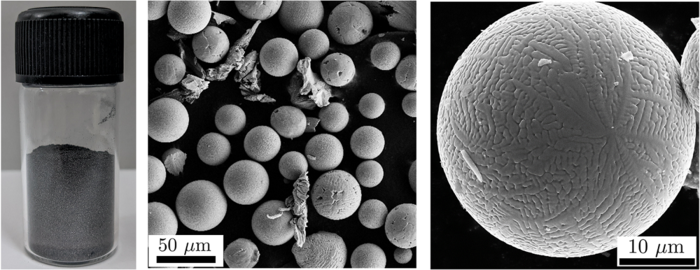Reviewed by Alex SmithApr 7 2022
Additive manufacturing (AM), also known as metal 3D printing, is a method of creating objects by layering materials. Metal powder is the significant source material for AM, and it is mostly made using an atomization technique, in which a molten metal stream is broken up into fine droplets utilizing air or water jets.
 Panel showing metal powders produced using the abrasion-based process. Image Credit: Laboratory for Advanced Manufacturing & Finishing Processes (LAMFiP), IISc.
Panel showing metal powders produced using the abrasion-based process. Image Credit: Laboratory for Advanced Manufacturing & Finishing Processes (LAMFiP), IISc.
In spite of its widespread use, however, atomization produces low yields, is expensive and is limited in the materials it can handle.
A group of researchers headed by Koushik Viswanathan, Assistant Professor in the Department of Mechanical Engineering at the Indian Institute of Science (IISc), has discovered an alternative method for producing metal powders that avoid these issues. This has important implications for additive manufacturing in general, including biomedical implant manufacturing.
The removed material, known as swarf, is frequently dismissed as a waste product in the metal grinding industry. It usually has a stringy appearance, similar to metal chips, but it can also produce perfectly spherical particles.
Researchers have long hypothesized that these bodies undergo a melting process to acquire their spherical shape, which raises some intriguing questions, such as whether the heat generated by the grinding causes the melting, and if there is any melting going on? Viswanathan’s group found that these powdery metal bodies develop as a result of melting at the surface layer caused by high heat from oxidation, an exothermic reaction.
They streamlined the process to make huge quantities of spherical powders, which are gathered and further processed to be used as AM stock material. In the context of metal AM, their studies suggest that these particles operate just as well as commercial gas atomized powders.
We have an alternative, more economical and inherently scalable route for making metal powders, and the quality of the final powders appear to be very competitive when compared with conventional gas atomized powders.
Priti Ranjan Panda, Study Co-Author and PhD Student, Centre for Product Design and Manufacturing, Indian Institute of Science
“There has been significant recent interest in adopting metal AM because by nature, it enables significant customization and allows design freedom. However, the large cost of stock metal powders has been the stumbling block. We hope that our work will open new doors to making cheaper and more accessible metal powders,” Viswanathan elaborates on the applications of their findings.
Reducing the cost of the AM process (via economical powders) can widen the range of materials in situations such as manufacturing of biomedical implants, which could become cheaper and more accessible.
Harish Singh Dhami, Study Co-Author and PhD Student, Department of Mechanical Engineering, Indian Institute of Science
According to the researchers, abrasion-based metal powder production has great promise in other high-performance applications like aircraft engines, where precision and sophistication are needed.
Metal powders are produced today at an atomization facility, which necessitates transportation for casting and recycling, resulting in a large supply chain. This works for common metals such as aluminum, but for strategic materials like tantalum and lithium, where extraction alone is a difficult process, having a scalable process to produce metal powders would be advantageous.
The entire supply chain could then be housed in a single facility, which is something that their method could provide.
Journal Reference:
Dhami, H. S., et al. (2022) Production of powders for metal additive manufacturing applications using surface grinding. Manufacturing Letters. doi.org/10.1016/j.mfglet.2022.02.004.